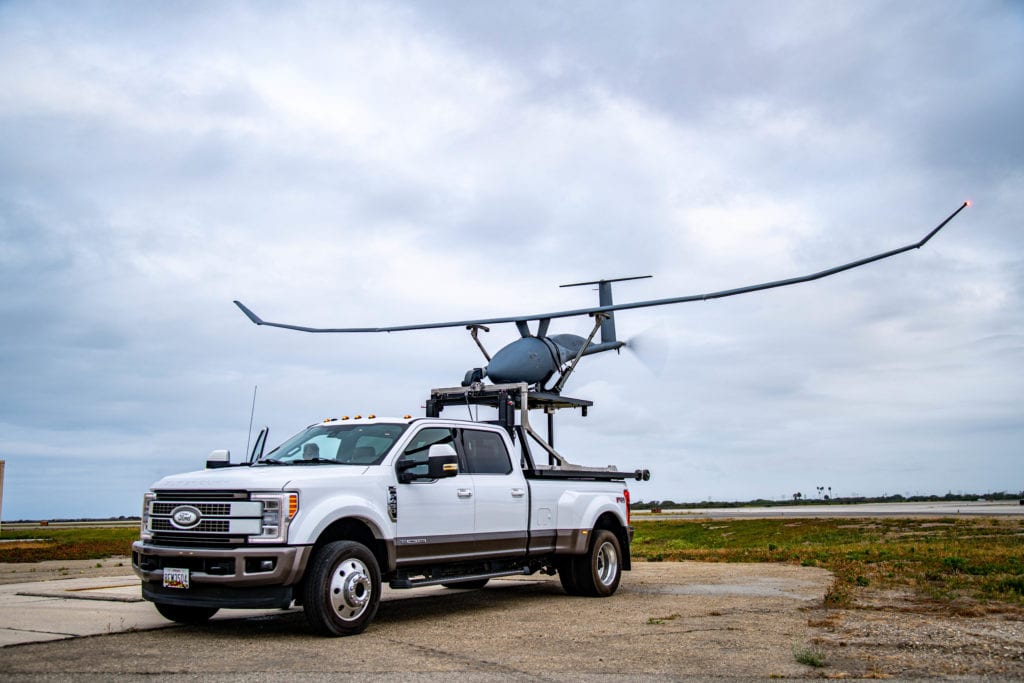
ARLINGTON, Va.— The Unmanned Systems Integrated Battle Problem (UxS IBP) conducted off the coast of California over the last week featured sensor data exchange and remote sensing in all domains from seabed to space, and involved a variety of scenarios, including swarm attacks by drones and launch and recovery of an unmanned underwater vehicle by a submarine.
Rear Adm. Robert Gaucher, director of the Maritime Headquarters for the U.S. Pacific Fleet, and Rear Adm. James Aiken, commander, Carrier Strike Group Three, and commander of the IBP, spoke about the exercise to reporters during an April 26 teleconference.
“Just yesterday, we successfully teamed air and surface manned and unmanned capability to put [an SM-6 missile] well past over the horizon from [the Arleigh Burke-class guided-missile destroyer USS] John Finn on a target and it struck the target very, very successfully,” Aiken said.
The manned/unmanned chain of events for the missile shoot was totally passive, [without] any active sensor. The target was detected by a combination of manned and unmanned platforms and a space system to locate and identify the target, track it with electronic support measures (ESM) bearings and pass the information to the John Finn, which was able to shoot the SM-6 at range, well beyond line of sight.
The admiral said the vignettes exercised during the IBP included focused warfighter vignettes, an anti-submarine warfare and surface ISR [intelligence, surveillance and reconnaissance] vignette, and an over-the-horizon strike vignette, the latter being the SM-6 event mentioned above.
Unmanned surface and air systems were used to prosecute a submarine-like target. This event included an MQ-9 SeaGuardian UAV dropping sonobuoys and up-linking data after a P-8 maritime patrol aircraft departed station.
In one scenario, a USV obtained an ESM electronic support measures bearing on a surface target, passed the locating data to the information warfare commander, who passed it to the surface warfare commander, who used a swarm drone attack against the target, a surface vessel.
During one event, a submarine was able to launch and recover an IVER-4 UUV using a torpedo tube.
“Being able to do that without divers [is] reducing a ton of risk for our divers to have to go recover … was a big win,” Gaucher said.
He also said the IVER-4 was able to conduct its own surveillance and reconnaissance and intelligence preparation of the battlespace.
“We were also able to deliver some kinetic effects in support of undersea and seabed warfare,” he said.
Control of unmanned systems during the IBP was conducted variously from a shore site, from ships at sea, or autonomously.
“I know that unmanned can proved me video from overhead,” Gaucher said. “I know I can put a towed array sensor on a medium-sized unmanned surface vessel, and I can control it from the shore for theater ASW. … I know that I can operate a system in and out of the torpedo tube of a submarine to support seabed warfare.”
“From a [Pacific Fleet] perspective, we were very pleased about how the Integrated Battle Problem came out, in particular with our ability to integrate unmanned [systems] into that battle problem in a contested environment,” Gaucher said, noting that 29 different unmanned technologies were part of the IBP, with about 50% surface, 30% subsurface, and 20% above the surface.
Gaucher stressed that goals for the IPB included using unmanned systems to avoid putting personnel in harm’s way and to improve targeting “so we get a better solution when we launch.”
- SECNAV Advocates Increased Legal Immigration to Increase Shipbuilder Workforce - April 23, 2024
- Insitu Going Strong at 30, Focusing on Maritime Operations - April 8, 2024
- Navy Awards Boeing Additional Funds for MQ-25 Drones for Testing - April 3, 2024






